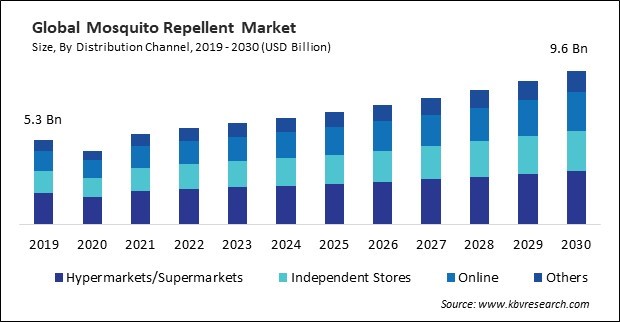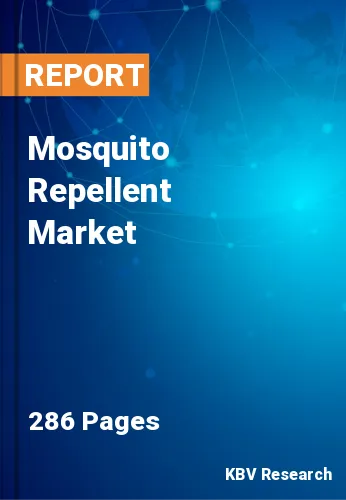“Global Mosquito Repellent Market to reach a market value of USD 9.6 Billion by 2030 growing at a CAGR of 6.1%”
The Global Mosquito Repellent Market size is expected to reach $9.6 billion by 2030, rising at a market growth of 6.1% CAGR during the forecast period. In the year 2022, the market attained a volume of 1,287.2 million units, experiencing a growth of 6.1% (2019-2022).
Mosquito coils are often cost-effective compared to other forms of mosquito repellents. Thus, the coil segment acquired $853.9 million in 2022. This affordability makes them popular in regions where cost is crucial for consumers. Coils are relatively easy to use. They require minimal setup and provide continuous protection against mosquitoes when burned, making them convenient for households.

A growing preference among consumers for natural, eco-friendly, and chemical-free repellents drives manufacturers to develop formulations using plant-based ingredients, catering to the demand of consumers of the market. The potential health hazards linked to repellents formulated with chemicals are a growing concern among consumers. Natural repellents are frequently considered preferable alternatives, particularly for allergic or respiratory individuals or those with sensitive skin. Consumers increasingly prioritize eco-friendly and sustainable products. Additionally, urbanization and changes in climate patterns contribute to the proliferation of mosquito habitats, leading to increased exposure to mosquitoes in both urban and rural areas, thereby boosting the demand for repellents. Urbanization often alters natural landscapes, creating more breeding grounds for mosquitoes. Construction sites, stagnant water in urban areas, and changes in temperature patterns due to urban heat islands can contribute to increased mosquito populations. Urbanization increases city density, exposing more people to potential mosquito-borne diseases. The increased interaction between humans and mosquito habitats heightens the demand for effective repellents as a preventive measure. Urbanization and climate change contribute to a complex interplay of factors affecting mosquito habitats, disease prevalence, and human exposure risks. Thus, rising urbanization and climate change are the factors propelling the growth of the market.
However, health and safety concerns related to mosquito repellents primarily revolve around several aspects, including chemical exposure, potential toxicity, and environmental impact. Some chemical-based repellents contain active ingredients that raise concerns about potential health risks with prolonged or excessive use. Consumer apprehensions about the safety of certain repellents can restrain market growth. Insecticides like permethrin in some repellents can affect non-target insects and animals, potentially disrupting ecosystems. Hence, mosquito repellents' health and safety concerns and adverse effects impede the market's growth.
On the basis of type, the market is segmented into coil, spray, cream & oil, vaporizer, mat, and others. The spray segment held the largest revenue share in the market in 2022. The increasing demand for mosquito repellent sprays reflects consumers' preferences for portable, easy-to-use, and effective solutions that provide immediate protection against mosquitoes. Maximum effectiveness and safety can be acquired by these by following manufacturer's instructions for proper application and reapplication.

Based on distribution channel, the market is divided into hypermarkets/supermarkets, independent stores, online, and others. The independent stores segment attained a significant revenue share in the market in 2022. These retail stores often serve local communities or specific neighborhoods. They cater to customers who prefer shopping closer to their homes, especially in areas where larger retail chains might not have a presence. Small retail stores may offer more personalized and attentive customer service. Store staff might better understand local customer preferences, allowing them to recommend specific repellents tailored to customers' needs.
Free Valuable Insights: Global Mosquito Repellent Market size to reach USD 9.6 Billion by 2030
Region-wise, the market is analyzed across North America, Europe, Asia Pacific, and LAMEA. The Asia Pacific region generated the maximum revenue share in the market in 2022. Consumer consciousness regarding the product's advantages continues to rise in Asia Pacific. The introduction of novel variations of goods and the growing approval of consumers towards these products will contribute to the expansion of the market in the region. Furthermore, the growing consciousness among residents of slums regarding the benefits of utilizing the product will stimulate market growth in this region.
| Report Attribute | Details |
|---|---|
| Market size value in 2022 | USD 6 Billion |
| Market size forecast in 2030 | USD 9.6 Billion |
| Base Year | 2022 |
| Historical Period | 2019 to 2021 |
| Forecast Period | 2023 to 2030 |
| Revenue Growth Rate | CAGR of 6.1% from 2023 to 2030 |
| Quantitative Data | Volume in Million Units, Revenue in USD Billion, and CAGR from 2019 to 2030 |
| Number of Pages | 286 |
| Number of Tables | 590 |
| Report coverage | Market Trends, Revenue Estimation and Forecast, Segmentation Analysis, Regional and Country Breakdown, Porter’s 5 Forces Analysis, Company Profiling, Companies Strategic Developments, SWOT Analysis, Winning Imperatives |
| Segments covered | Type, Distribution Channel, Region |
| Country scope |
|
| Companies Included | S. C. Johnson & Son, Inc., Reckitt Benckiser Group PLC, Henkel AG & Company, KGaA, Spectrum Brands Holdings, Inc., Johnson & Johnson Services, Inc. (Johnson & Johnson), Himalaya Wellness Company (Himalaya Global Holdings Ltd.), Dabur India Ltd., Natura & Co Holding SA, 3M Company, Godrej Consumer Products Ltd. (Godrej Group) |
By Distribution Channel (Volume, Million units, USD Billion, 2019-2030)
By Type (Volume, Million units, USD Billion, 2019-2030)
By Geography (Volume, Million units, USD Billion, 2019-2030)
The Market size is projected to reach USD $9.6 billion by 2030.
Rising consumer preferences for natural products are driving the Market in coming years, however, Significant number of health and safety concerns restraints the growth of the Market.
S. C. Johnson & Son, Inc., Reckitt Benckiser Group PLC, Henkel AG & Company, KGaA, Spectrum Brands Holdings, Inc., Johnson & Johnson Services, Inc. (Johnson & Johnson), Himalaya Wellness Company (Himalaya Global Holdings Ltd.), Dabur India Ltd., Natura & Co Holding SA, 3M Company, Godrej Consumer Products Ltd. (Godrej Group)
The expected CAGR of this Market is 6.1% from 2023 to 2030.
The Hypermarkets/Supermarkets segment is leading the Market, by Distribution Channel in 2022; thereby, achieving a market value of $3.4 Billion by 2030.
The Asia Pacific region dominated the Market, by Region in 2022, and would continue to be a dominant market till 2030; thereby, achieving a market value of $4.1 Billion by 2030.
Our team of dedicated experts can provide you with attractive expansion opportunities for your business.

 Drivers
Drivers
 Restraints
Restraints
